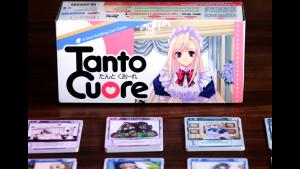

March 18, 2012 Unlike video games, board games seem to have very little crossover between Japan and North America. Every now and then, however, a Japanese crafted title catches my eye and reaffirms my belief that when western mechanics and Japanese sensibilities collide, the result can be uniquely compelling. Tanto Cuore is one such game.
Modeled after the hugely successful card game Dominion, Tanto Cuore strips away the medieval theme of its predecessor and replaces it with the quirky premise of managing a house full of French maids. Seen in a number of Manga and Anime series, as well as in cafés sprinkled throughout the land of the rising sun, the French maid has become somewhat of a cultural phenomenon in Japan, so it's no surprise to find the theme attached to a card game. It is surprising, however, that the game itself manages to transcend its theme and deliver a fun and strategic gameplay experience.
Tanto Cuore belongs to the fairly recent style of game called a "Deck Building Game," made popular by the 2008 release of "Dominion." To fully understand the history and impact this new genre has had on board games, we need to step back two decades into the early 90's when a little game called "Magic: The Gathering" rocked the hobby game world. Magic: The Gathering introduced the world to the Collectible Card Game (CCG), a style of game that requires players to purchase random booster packs of cards and rearrange them to create a unique deck. While the game proper consists of players battling each other using these cards, the real meat of "Magic: The Gathering" is in the strategic construction of the players' decks. Despite its undeniable popularity, Magic: The Gathering has been decried by many as a money sink, its random booster model rewarding those who invest the most money buying cards.
 Fast forward to 2008: The newly released Dominion sought to deliver the fun of building a custom deck that Magic: The Gathering offered without the financial anchor of purchasing countless booster packs. Where the deck building in Magic: The Gathering was a prelude to a game, Dominion actually turned deck building into a game itself. The basic premise of a deck building game is this: In the center of the table are a collection of cards, some are worth victory points, some are worth money, and some have unique rule-bending abilities. Players utilize cards from their hand to gain points and money and are given the opportunity to buy more cards from the center of the table. Purchased cards are placed directly into the player's personal discard pile – but when the player runs out of cards to draw, the discard pile is shuffled, and the cards that were placed in the discard pile become his new deck. In this way, the cards purchased in previous rounds are brought into the player's hand.
Fast forward to 2008: The newly released Dominion sought to deliver the fun of building a custom deck that Magic: The Gathering offered without the financial anchor of purchasing countless booster packs. Where the deck building in Magic: The Gathering was a prelude to a game, Dominion actually turned deck building into a game itself. The basic premise of a deck building game is this: In the center of the table are a collection of cards, some are worth victory points, some are worth money, and some have unique rule-bending abilities. Players utilize cards from their hand to gain points and money and are given the opportunity to buy more cards from the center of the table. Purchased cards are placed directly into the player's personal discard pile – but when the player runs out of cards to draw, the discard pile is shuffled, and the cards that were placed in the discard pile become his new deck. In this way, the cards purchased in previous rounds are brought into the player's hand.
Tanto Cuore keeps this basic structure, but adds some twists that give it a unique flavor. First and foremost, you are master of the house, and collect maid cards from the center of the board. Where most maids in the real world work for cold hard cash, the maids in Tanto Cuore are happy working for "love," the basic currency in the game. Each type of maid has special abilities to assist in hiring more maids as well as keeping the other maids healthy and happy. With all of these different abilities, it can be a lot of fun to hire maids in a strategic manner, allowing cards to be played in long chains that drastically increase the player's ability to acquire more powerful cards.
 While most cards in the game are played from the hand and discarded after use, Tanto Cuore allows players to put cards in his "chambers," an area of the board where certain cards can be set aside. These cards are called "chambermaids" and "private maids," and generate an effect every turn. It's through these special cards that player conflict is introduced into the game. Players can buy illnesses and bad habits which they can play on an opponent to negate his private maid's effect. This adds a bit of a "take-that" flavor to gameplay and encourages direct player interaction.
While most cards in the game are played from the hand and discarded after use, Tanto Cuore allows players to put cards in his "chambers," an area of the board where certain cards can be set aside. These cards are called "chambermaids" and "private maids," and generate an effect every turn. It's through these special cards that player conflict is introduced into the game. Players can buy illnesses and bad habits which they can play on an opponent to negate his private maid's effect. This adds a bit of a "take-that" flavor to gameplay and encourages direct player interaction.
Each type of maid is worth a certain number of victory points, and players continue to strategically play their cards until a given number of card piles at the center of the table have been depleted. At the end of the game, the person with the most victory points is the winner (and probably has more maids in his house than he knows what to do with.)
The cards in Tanto Cuore are high quality and handle well in their full color, anime styled glory. They come packed in a box with dividers and spacers to make organizing the different piles of cards very easy. The cards sport clear icons to describe the four basic effects that a card can give. The use of icons is a great boon because it is language neutral, allows the player to glance at the card and see its abilities, and frees up space on the card to describe any other effects provided.
 The game's manual is very well translated, avoiding the broken English and obtuse sentence structure that plagues many foreign designed games. That's not to say the manual is perfect though, as it suffers from its own brand of understandability issues that stem from the thematic terminology used to describe things. While a player might inherently understand what a draw deck and discard pile are, the Tanto Cuore manual chooses to refer to them as the "Waiting Room" and "Kitchen Entrance" respectively. While I agree this might add thematic charm to the game, it really does hinder clear communication. A game's theme should work to enhance understanding of the mechanics, not as a barrier to clarity. In this same vein, the four basic properties that a card can modify are referred to as "Callings," "Love," "Employment," and "Servings," terminology much more difficult to understand compared to that used in the majority of similar games (Card Draws, Money, Buys, and Actions).
The game's manual is very well translated, avoiding the broken English and obtuse sentence structure that plagues many foreign designed games. That's not to say the manual is perfect though, as it suffers from its own brand of understandability issues that stem from the thematic terminology used to describe things. While a player might inherently understand what a draw deck and discard pile are, the Tanto Cuore manual chooses to refer to them as the "Waiting Room" and "Kitchen Entrance" respectively. While I agree this might add thematic charm to the game, it really does hinder clear communication. A game's theme should work to enhance understanding of the mechanics, not as a barrier to clarity. In this same vein, the four basic properties that a card can modify are referred to as "Callings," "Love," "Employment," and "Servings," terminology much more difficult to understand compared to that used in the majority of similar games (Card Draws, Money, Buys, and Actions).
While a player familiar with other deck building titles such as "Dominion" should have no trouble making the mental conversion to the new terms, it may be a bit confusing for players that are new to the genre.
The titles of the cards themselves could be more descriptive as well. They don't really telegraph what the card actually does, instead giving the French-sounding names of the maids they depict. In all fairness, the ambiguity of card titles is a problem that faces many deck building games, but Tanto Cuore may suffer more than others. While a player might be able to give a loose association to a card like "Moat," or "Bureaucrat" in another game, it's much more difficult to make that associative leap for the cards in Tanto Cuore which are named things like "Ophelia Grail" and "Anise Greenaway."
Those issues aside, Tanto Cuore takes enough creative licenses with the standard deck building recipe to warrant play. The inclusion of the persistent chambermaid and private maid cards creates an interesting layer of strategy that intensifies the conflict between players. This twist creates a game that is quite a lot of fun, and the addition of the whimsical theme certainly gives it a lot of character.
 The theme is something that each potential player will have to evaluate for himself, though. While there is little overt fan service (one or two cards do contain panty shots), the game does hint at overtones that may not be completely innocent – but certainly nothing that wouldn't be found on a typical Japanese broadcast anime series.
The theme is something that each potential player will have to evaluate for himself, though. While there is little overt fan service (one or two cards do contain panty shots), the game does hint at overtones that may not be completely innocent – but certainly nothing that wouldn't be found on a typical Japanese broadcast anime series.
If you are a fan of anime, then Tanto Cuore is definitely a great alternative to the glut of deck building games with a stodgy Medieval European theme. While it may not break much new ground mechanically, it is a very fun game and just as effective from a gameplay standpoint as the other deck building games it closely emulates. The game's Japanese heritage really shines through and works to turn what many find a dry genre into one with its own playful personality. As such, Tanto Cuore stays true to its Italian sourced name – it most certainly has "Much Heart".
Tanto Cuore was developed by Arclight Games and is distributed in North America through Japanime Games.
Video game programmer by day and avid boardgamer by night, William McCarroll regularly contributes board game-related reviews and commentary at www.nerdbloggers.com.